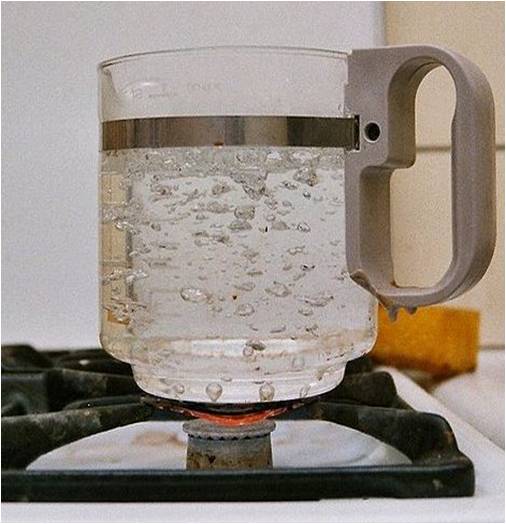This week, comments from guest blogger and International Space Station Associate Program Scientist Tara Ruttley, Ph.D., as she reflects on the physical science of boiling in space.
If you don’t think of yourself as the type of person who could ever be interested in physics, let’s boil this down.
You’re hungry. It’s pasta time. Your pot of water is on the stove, you’ve turned on the maximum heat, and the wait for boiling begins. You are staring impatiently at the pot when the water looks like it’s starting to swirl. You’re anxious to see the bubbles that signify that you can put your pasta into that water. But what do those bubbles tell you and what makes them the key indicator of perfect pasta water temperature?

On Earth, water boils via natural convection.
(Image courtesy of Markus Schweiss via Wikipedia)
To simplify a bit, boiling is actually a very efficient heat transfer process and, in this case, boiling transfers the heat from the fire on your stove to the water that will cook your pasta. It seems straight-forward enough here on Earth: you turn on the burner, wait a few minutes, and when all those small bubbles appear, you’re ready to get cooking.
As you wait for your pot of water to boil, there is a complex process going on in there. First, the liquid on the bottom of the pot closest to the heat source starts to get hot; as it does, it rises. The rising hot water is replaced by the cooler, more dense water molecules. The water molecules in your pot continually exchange in this way, thanks to gravity, eventually warming the entire pot of liquid. This is known as natural convection—the movement of molecules through fluid—which is a primary method of heat (and mass) transfer.
Without buoyancy or convection, boiling fluids
behave quite differently in space.
(Video courtesy of NASA)
But natural convection is not enough, as it does not yet provide those bubbles you need for your pasta. To get those bubbles, you have to wait long enough for the bottom of the pot to get hotter than the boiling point of the water. When the boiling point is breached, you finally begin to see the tiny bubbles of water vapor you’ve been waiting for! The bubbles rise, due to buoyancy, and then collapse as they reach the denser, relatively cooler water at the surface of the pot. This motion not only helps to move the water around more quickly (think stirring), but the bubbles themselves transfer heat energy as well. This bubble formation is called nucleate boiling; a far more effective way to transfer heat than natural convection on its own. In fact, so effective that ultimately it leads to more complex boiling called transition boiling—the highly turbulent bubble flow that indicates the water is now hot enough to cook your pasta.
In space, however, bubbles behave differently. Without gravity, the effects of buoyancy and convection are absent. The warmer water cannot rise; instead it remains near the heat source, getting hotter and hotter. Meanwhile, the remaining water further away from the heat source stays relatively cool. As the heated fluid reaches its boiling point, the bubbles do not rise to the surface. Instead, the bubbles that do form coalesce into one large bubble that sits on the heated surface. Within the bubble lies precious heat energy, trapped! The result is a seemingly inefficient or at least very different, way to transfer heat.

Image of liquid boiling on a heater array during the low gravity
produced by NASA’s KC-135 aircraft. Blue regions indicate
regions of low heat transfer.
(Courtesy of University of Maryland)
As it turns out, there are plenty of scientists out there who are fascinated with the fact that if you boil water in space, you get one large bubble that tends to “swallow” smaller bubbles. Why the fascination? Well, beyond the gains in fundamental thermodynamics “textbook” knowledge, because boiling is such an effective heat transfer process, understanding more about this complex process can help to build more efficient cooling systems for Earth and space. For example, automotive engineers are interested in designing compact, energy-efficient systems to cool off hot car engines, based on the heat transfer mechanics of boiling.
In fact, your own refrigerator uses a coolant with a low boiling point and some associated pressure changes in order to keep your food cold inside. By transferring heat from the fridge air to the coolant to the point of boiling, heat ultimately dissipates from the bubbles and radiates out into the air in your home. In essence, although the air inside of your fridge may seem cold to you, it is actually warm enough to boil its coolant, which is the very heat transfer process responsible for keeping your food cold.
The Boiling Experiment Facility or BXF, which launched on STS-133 in February 2010, will enable scientists to perform in-depth studies of the complexities involved in bubble formation as a result of heat transfer. For instance, what roles do surface tension and evaporation play during nucleate boiling when buoyancy and convection are not in the equation? What about the variations in the properties of the heating surface? By controlling for gravity while on the International Space Station, scientists can investigate the various elements of boiling, thus potentially driving improved cooling system designs. Improved efficiency in cooling technology can lead to positive impacts on the global economy and environment; two hot topics that have much to gain from boiling in space.
Dr. Tara Ruttley is an Associate Program Scientist for the International Space Station (ISS) for the National Aeronautics and Space Administration (NASA) at Johnson Space Center (JSC) in Houston. Her role in the Program Science Office consists of representing and communicating all research on the space station, and supporting recommendations to the ISS Program Manager and to NASA Headquarters, regarding research on the ISS. Prior to her role in the ISS Program Science Office, Dr. Ruttley served as the lead flight hardware engineer for the ISS Health Maintenance System, and later for the ISS Human Research Facility. She has a Bachelor of Science degree in Biology and a Master of Science degree in Mechanical Engineering from Colorado State University, and a Doctor of Philosophy degree in Neuroscience from the University of Texas Medical Branch. Dr. Ruttley has authored publications ranging from hardware design to neurological science, and also holds a U.S. utility patent.

Dr. Tara Ruttley
(NASA Image)

Hello.
i would like to have some links or studies/research of the theoretical aspects of boiling of liquids in microgravity.
I find it very interesting.
I’m a physicists and would like to read more about it.
Kind regards,
Mehender
The Hague
Holland
hi, I am the student Indian institute of technology here in India. I am doing some research/project work on flow boiling (two phase) in micro-channels.I wanted to know that, what is the reason of growing of bubble size. Is it because of evaporation at the interface of liquid vapor surface? or it is because temperature of some point of bottom surface of heating element increase so that specific volume increase and same mass require more space?
I also need your help for some material for study please suggest me. I am a under graduate student of final year of mechanical engineering. Please help me ……..
Hello kapil,
The resulting increase in bubble size is due to the inability for the heated air near the heat source to rise because of lack of (or negligible) convection in microgravity. I hope this helps…
a brief and simplified theory.
Explained well enough.
Thanks for making me understand this concept.
I have a question :: What is the condition for bubble to be in equilibrium with surrounding ?
Hi Mayank-
Thanks for your question. Part of the reason we are studying bubbles aboard the space station is to answer questions about phenomena, such as your question on the equilibrium behavior of bubbles in space, which are not currently understood.
My name is Myron.
I am a recent graduate of the University of Kwa-Zulu Natal, Durban, South Africa under the discipline of Mechanical engineering. I have just read your report on bubbles and their effects on heat transfer. It was very interesting and enlightening.
The question I pose to you is that if I want to cool and maintain the temperature of a vat of chilled water (10℃) by using glycol cooled air (5℃) bubbled underneath it within a room tempearture of 15℃, will this in fact cool the water further or perhaps with its mixing and turbulent inducing capabilities have the opposite effect and heat it up? I was told by my Professor that if no phase change commences (such as steam being passed into cold water, condensing and passing off its heat) it would make no difference at all in terms of cooling or heating up. All you would get is agitated water.
If you stir a cup of hot coffee at 70℃, you increase the heat transfer rate with the room temperature which as you know then follows the 2nd law of thermodynamics. However in this case, we have the opposite situation to the analogy above: the fluid is at a lower temperature than the room temperature and if we follow the 2nd law, heat from the ambient air around it will actually be absorbed by the fluid and if mixed vigorously the heat transfer rate is increased. However this can only occur if what my Professor says is true, that the colder air bubbles have no effect on cooling, only in agitation.
Looking forward to any reply.
If there are any reports similar to this subject, please can you send me a link or an attachment of any kind.
Yours faithfully
Myron Nobin (BSc. Eng, UKZN)